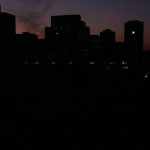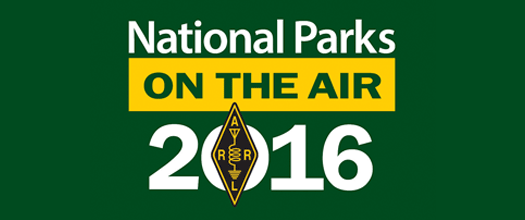Archive for the ‘arrl’ Category
 New Year’s Day
New Year’s Day
I got on for a bit last night for SKN. I don't know if it was just bad band conditions with the remnants of that CME lingering; or perhaps it was my atrocious bug fist. I made no contacts last night.
During the day today, I did a bit better. I worked five different NPOTA activations (6 QSOs):
N8XX - TR04 - North County National Scenic Trail
W1BXY - NS76 - Weir Farm National Historic Sight
NC8IN - NS55 - Ninety Six National Historic Sight
NR3P - SS01 - Assateague Island National Seashore
KK4ZUU - BP02 - Mnasassas National Battlefield Park
K7UPJ - NS55- Ninety Six National Historic Sight
I just realized now that I worked NS55 twice. Basically, I was dial twiddling, working the ones I could hear decently. There were a few others, but QSB was so bad on 20 Meters at times that I bypassed a few, thinking conditions would get better. They didn't, and going back to try and work those again, I found them to be gone. Sometimes the Propagation Princess is a cruel mistress!
Only N8XX and NR3P were CW, though. I had to break out the microphone and resort to SSB for the others. As Yoda would say, "A disturbing trend in The Force, I sense".
As mentioned in an earlier post, the 2016 NJQRP Skeeter Hunt will be featuring NPOTA - but let that be just a foot note. I would hope that a lot of you who read this blog regularly will step up the plate and activate NPOTA entities using CW (and QRP).
Remember, it doesn't have to be an elaborate set up, with multi ops and crazy antenna installations that last all day. This NPOTA program was tailor made for portable QRP ops! Go to one of the entities, throw a wire into a tree, or perhaps break out the Buddistick, Buddipole, Alex Loop - what have you. Get on the air for a few hours and hand out some contacts!
Also, remember that this is a year long celebration. There were a bumper crop of NPOTA activations on the air today. It seems that everyone wanted to be active on "Day One", but there are 365 days left (this is a Leap Year, don't forget). So get out there and have some fun. That's what this is all about - going outdoors, setting up and having some fun.
This is OUR specialty, guys! Let's show them how it's done!
72 de Larry W2LJ
QRP - When you care to send the very least!
 Get Ready: Month-long Special Event for SKCC, the 2016 K3Y Celebration
Get Ready: Month-long Special Event for SKCC, the 2016 K3Y Celebration
Are you ready for the annual, month-long special event by the Straight Key Century Club (SKCC)? The SKCC Group membership is free, and celebrates the longest tradition of amateur radio: Morse code. But, not just any Morse code. The manual creation of Morse code by “straight” keys means no electronic origin, only mechanical. This is a month-long event, during January 2016, modelled after the ARRL Straight Key Night.
Here’s a video that I made showing my activity as the control operator of the special event station, K3Y/0, during one of the many shifts during January (2015). K3Y is the special event callsign of the Straight Key Century Club (SKCC). The special event operates each January. I’ll be doing this again, this coming month, January of 2016.
K3Y, the Straight Key Century Club’s annual January celebration, commemorates the club’s founding in 2006 following the American Radio Relay League’s Straight Key Night. A small group of participants wanted to extend the fun of SKN throughout the year. The SKCC is the result.
For the first three years, the club’s founders used K1Y, K2A, and K3Y as the celebration’s special-event calls. But someone cleverly noticed that a 3 is nothing more than a backwards, curvaceous E. This “KEY” event has operated under the K3Y call ever since.
The on-air party is open to members and non-members alike. It runs from 0000 UTC Jan. 2 through 2359 UTC Jan. 31. It’s a great time to introduce others to the joys of hand-crafted Morse code using straight keys, bugs, and side swipers.
This year, January 2016, we’ll be fielding K3Y operators in each of the 10 US call areas, plus KH6, KL7 and KP4, along with specially scheduled stations in each of six IARU continental regions. Your QSOs with event operators in all these 19 areas will be tabulated in the Statistics section and can be confirmed with a K3Y QSL card and Sweep Certificate.
+ The SKCC website is at http://skccgroup.com
+ The K3Y special event page is http://www.skccgroup.com/k3y/
73 de NW7US
dit dit
 LHS Episode #157: Canada Goes Dark
LHS Episode #157: Canada Goes Dark
 Hello, everyone! Welcome to the latest installment of Linux in the Ham Shack. Today your hosts discuss a new, incredibly inexpensive single-board computer, an ARRL contest slated to last all of 2016, politics vs. emcomm, a re-written DOS-based contest logger and much, much more. Thanks as always for tuning in and we hope you have a safe and happy holiday season.
Hello, everyone! Welcome to the latest installment of Linux in the Ham Shack. Today your hosts discuss a new, incredibly inexpensive single-board computer, an ARRL contest slated to last all of 2016, politics vs. emcomm, a re-written DOS-based contest logger and much, much more. Thanks as always for tuning in and we hope you have a safe and happy holiday season.
73 de The LHS Crew
 National Parks On The Air
National Parks On The Air

From the ARRL: “Throughout 2016, Amateur Radio will be helping the National Park Service celebrate their 100th anniversary. Hams from across the country will activate NPS units, promote the National Park Service and showcase Amateur Radio to the public.”
This should be an exciting event for me. This past summer I got to enjoy some extended travels through a few of our national parks (visited a total of 5). This coming summer I am planning the same but hopefully am going to be able to visit even more.
While I do not intend to conduct any extended activations, I do plan on getting onto the HF bands from my mobile while I am at the parks.
I am getting closer to locking in my summer travel’s calendar. Most parks start taking reservations at six months out… just about there.
ARRL is already selling quite a bit of National Parks On The Air (NPOTA) swag. One item that I have ordered is the NPOTA map, which I’ll post in the room where I will do my trip planning.

I will need to think through how I cam going to do my logging. For QSL cards, I can use postcards from the park and stamp them with each park’s National Park Passport stamp.

 ARRL Bulletin 25
ARRL Bulletin 25
ARLB025 FCC Universal Licensing System, Other Applications to be Down for Maintenance
ZCZC AG25
QST de W1AW
ARRL Bulletin 25 ARLB025
From ARRL Headquarters - Newington CT August 25, 2015
To all radio amateurs
SB QST ARL ARLB025
ARLB025 FCC Universal Licensing System, Other Applications to be Down for Maintenance
FCC website maintenance in early September will make the Universal Licensing System (ULS), the Electronic Comment Filing System (ECFS), the Electronic Document Management System (EDOCS) and other public applications unavailable for more than 5 days. The Commission said the outage will begin at 2200 UTC on Wednesday, September 2, and continue through the Labor Day weekend. The maintenance work should be completed by 1200 UTC on Tuesday, September 8. During the ULS outage, it will not be possible to file any Amateur Radio applications.
"[M]ost Commission resources normally accessible through the Commission's website, including access to all electronic filing systems and electronic dockets, will be inaccessible for the same period, with the exception of the Network Outage Reporting System (NORS), the Consumer Help Center (CHC), and the Disaster Information Reporting System (DIRS), which will remain available," an FCC Public Notice said on August 20. "The Commission's website will remain available, but with reduced content and limited search capabilities." According to the Public Notice, the FCC will follow its normal schedule of operation during the maintenance period, but voicemail will be offline, and most Commission staffers will not have access to e-mail. Static content webpages on the fcc.gov domain, such as the FCC consumer guides, should remain available during the outage.
The FCC will extend filing deadlines for all regulatory and enforcement filings that fall during the maintenance period. Filings due on September 2, 3, 4, or 8 now will be due on Wednesday, September 9. "Except for the due dates specified herein, we are not automatically extending the deadlines for any other comment or filing periods that will be running during this time period, but requests for extension of time will be considered consistent with the Commission's normal practice," the FCC Public Notice said. "To the extent the due dates for filings to which reply or responsive pleadings are allowed are affected by this Public Notice, the due dates for reply or responsive pleadings shall be extended by the same number of days."
In a blog, "Modernizing the FCC's IT," FCC CIO David Bray said that with the world and the technology we use are changing rapidly, "the information technology used by the Federal Communications Commission must change as well." Bray said the FCC has "made significant progress to upgrade and modernize our infrastructure, and we continue to work on modernizing the FCC's legacy IT systems with the resources we have available."
"We understand that this temporary downtime before and during the Labor Day Weekend may be inconvenient for some FCC stakeholders," Bray added.
NNNN /EX
72 de Larry W2LJ
QRP - When you care to send the very least!
 LHS Episode #152: Man Smart (Woman Smarter)
LHS Episode #152: Man Smart (Woman Smarter)
 Hello, ladies and gentlemen! It's time for another action filled episode of Linux in the Ham Shack. Topics for this episode include, women in technology, the Amateur Radio Parity Act of 2015, photo editors (of all things), databases for Linux hardware compatibility, ham radio-specific Linux distributions and much more. Thanks for spending an hour of your day with us. We appreciate all of our listeners. Also, don't forget to send us feedback. We'd love to hear from you.
Hello, ladies and gentlemen! It's time for another action filled episode of Linux in the Ham Shack. Topics for this episode include, women in technology, the Amateur Radio Parity Act of 2015, photo editors (of all things), databases for Linux hardware compatibility, ham radio-specific Linux distributions and much more. Thanks for spending an hour of your day with us. We appreciate all of our listeners. Also, don't forget to send us feedback. We'd love to hear from you.
73 de The LHS Guys
 Our Amazing Sun and HF Radio Signal Propagation
Our Amazing Sun and HF Radio Signal Propagation
Space Weather. The Sun-Earth Connection. Ionospheric radio propagation. Solar storms. Coronal Mass Ejections (CMEs). Solar flares and radio blackouts. All of these topics are interrelated for the amateur radio operator, especially when the activity involves the shortwave, or high-frequency, radiowave spectrum.
Learning about space weather and radio signal propagation via the ionosphere aids you in gaining a competitive edge in radio DX contests. Want to forecast the radio propagation for the next weekend so you know whether or not you should attend to the Honey-do list, or declare a radio day?
In the last ten years, amazing technological advances have been made in heliophysics research and solar observation. These advances have catapulted the amateur radio hobbyist into a new era in which computer power and easy access to huge amounts of data assist in learning about, observing, and forecasting space weather and to gain an understanding of how space weather impacts shortwave radio propagation, aurora propagation, and so on.
I hope to start “blogging” here about space weather and the propagation of radio waves, as time allows. I hope this finds a place in your journey of exploring the Sun-Earth connection and the science of radio communication.
With that in mind, I’d like to share some pretty cool science. Even though the video material in this article are from 2010, they provide a view of our Sun with the stunning solar tsunami event:
On August 1, 2010, the entire Earth-facing side of the sun erupted in a tumult of activity. There was a C3-class solar flare, a solar tsunami, multiple plasma-filled filaments of magnetism lifting off the stellar surface, large-scale shaking of the solar corona, radio bursts, a coronal mass ejection and more!
At approximately 0855 UTC on August 1, 2010, a C3.2 magnitude soft X-ray flare erupted from NOAA Active Sunspot Region 11092 (we typically shorten this by dropping the first digit: NOAA AR 1092).
At nearly the same time, a massive filament eruption occurred. Prior to the filament’s eruption, NASA’s Solar Dynamics Observatory (SDO) AIA instruments revealed an enormous plasma filament stretching across the sun’s northern hemisphere. When the solar shock wave triggered by the C3.2-class X-ray explosion plowed through this filament, it caused the filament to erupt, sending out a huge plasma cloud.
In this movie, taken by SDO AIA at several different Extreme Ultra Violet (EUV) wavelengths such as the 304- and 171-Angstrom wavelengths, a cooler shock wave can be seen emerging from the origin of the X-ray flare and sweeping across the Sun’s northern hemisphere into the filament field. The impact of this shock wave may propelled the filament into space.
This movie seems to support this analysis: Despite the approximately 400,000 kilometer distance between the flare and the filament eruption, they appear to erupt together. How can this be? Most likely they’re connected by long-range magnetic fields (remember: we cannot see these magnetic field lines unless there is plasma riding these fields).
In the following video clip, taken by SDO AIA at the 304-Angstrom wavelength, a cooler shock wave can be seen emerging from the origin of the X-ray flare and sweeping across the sun’s northern hemisphere into the filament field. The impact of this shock wave propelled the filament into space. This is in black and white because we’re capturing the EUV at the 304-Angstrom wavelength, which we cannot see. SDO does add artificial color to these images, but the raw footage is in this non-colorized view.
The followling video shows this event in the 171-Angstrom wavelength, and highlights more of the flare event:
The following related video shows the “resulting” shock wave several days later. Note that this did NOT result in anything more than a bit of aurora seen by folks living in high-latitude areas (like Norway, for instance).
This fourth video sequence (of the five in the first video shown in this article) shows a simulation model of real-time passage of the solar wind. In this segment, the plasma cloud that was ejected from this solar tsunami event is seen in the data and simulation, passing by Earth and impacting the magnetosphere. This results in the disturbance of the geomagnetic field, triggering aurora and ionospheric depressions that degrade shortwave radio wave propagation.
At about 2/3rd of the way through, UTC time stamp 1651 UTC, the shock wave hits the magnetosphere.
This is a simulation derived from satellite data of the interaction between the solar wind, the earth’s magnetosphere, and earth’s ionosphere. This triggered aurora on August 4, 2010, as the geomagnetic field became stormy (Kp was at or above 5).
While this is an amazing event, a complex series of eruptions involving most of the visible surface of the sun occurred, ejecting plasma toward the Earth, the energy that was transferred by the plasma mass that was ejected by the two eruptions (first, the slower-moving coronal mass ejection originating in the C-class X-ray flare at sunspot region 1092, and, second, the faster-moving plasma ejection originating in the filament eruption) was “moderate.” This event, especially in relationship with the Earth through the Sun-Earth connection, was rather low in energy. It did not result in any news-worthy events on Earth–no laptops were fried, no power grids failed, and the geomagnetic activity level was only moderate, with limited degradation observed on the shortwave radio spectrum.
This “Solar Tsunami” is actually categorized as a “Moreton wave”, the chromospheric signature of a large-scale solar coronal shock wave. As can be seen in this video, they are generated by solar flares. They are named for American astronomer, Gail Moreton, an observer at the Lockheed Solar Observatory in Burbank who spotted them in 1959. He discovered them in time-lapse photography of the chromosphere in the light of the Balmer alpha transition.
Moreton waves propagate at a speed of 250 to 1500 km/s (kilometers per second). A solar scientist, Yutaka Uchida, has interpreted Moreton waves as MHD fast-mode shock waves propagating in the corona. He links them to type II radio bursts, which are radio-wave discharges created when coronal mass ejections accelerate shocks.
I will be posting more of these kinds of posts, some of them explaining the interaction between space weather and the propagation of radio signals.
For live space weather and radio propagation, visit http://SunSpotWatch.com/. Be sure to subscribe to my YouTube channel: https://YouTube.com/NW7US.
The fourth video segment is used by written permission, granted to NW7US by NICT. The movie is copyright@NICT, Japan. The rest of the video is courtesy of SDO/AIA and NASA. Music is courtesy of YouTube, from their free-to-use music library. Video copyright, 2015, by Tomas Hood / NW7US. All rights reserved.












